CADILLAC STS 2011 1.G Owners Manual
Manufacturer: CADILLAC, Model Year: 2011, Model line: STS, Model: CADILLAC STS 2011 1.GPages: 528, PDF Size: 4.96 MB
Page 211 of 528
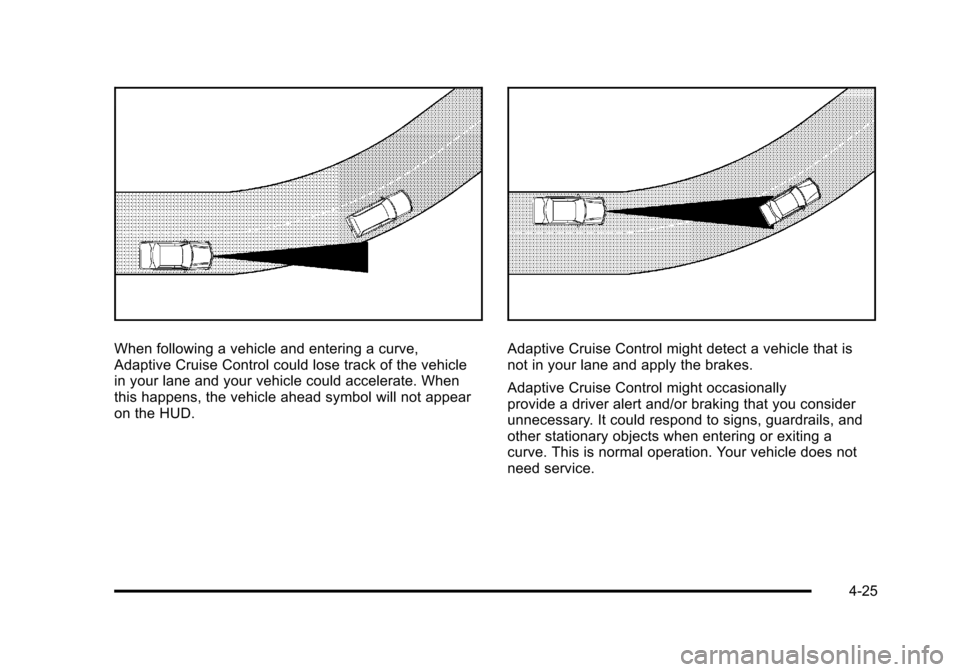
Black plate (25,1)Cadillac STS Owner Manual - 2011
When following a vehicle and entering a curve,
Adaptive Cruise Control could lose track of the vehicle
in your lane and your vehicle could accelerate. When
this happens, the vehicle ahead symbol will not appear
on the HUD.Adaptive Cruise Control might detect a vehicle that is
not in your lane and apply the brakes.
Adaptive Cruise Control might occasionally
provide a driver alert and/or braking that you consider
unnecessary. It could respond to signs, guardrails, and
other stationary objects when entering or exiting a
curve. This is normal operation. Your vehicle does not
need service.
4-25
Page 212 of 528
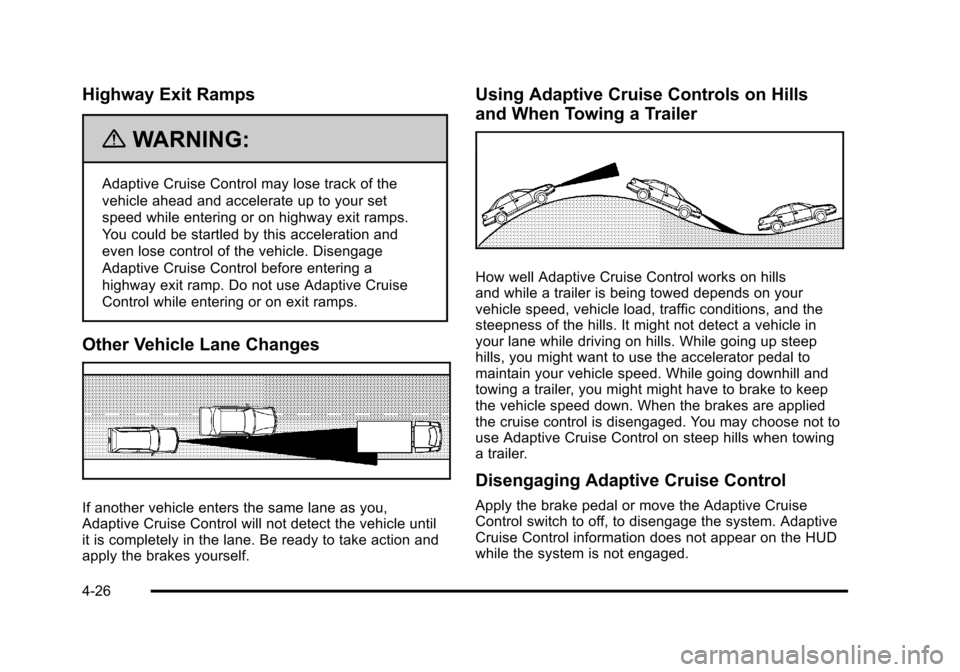
Black plate (26,1)Cadillac STS Owner Manual - 2011
Highway Exit Ramps
{WARNING:
Adaptive Cruise Control may lose track of the
vehicle ahead and accelerate up to your set
speed while entering or on highway exit ramps.
You could be startled by this acceleration and
even lose control of the vehicle. Disengage
Adaptive Cruise Control before entering a
highway exit ramp. Do not use Adaptive Cruise
Control while entering or on exit ramps.
Other Vehicle Lane Changes
If another vehicle enters the same lane as you,
Adaptive Cruise Control will not detect the vehicle until
it is completely in the lane. Be ready to take action and
apply the brakes yourself.
Using Adaptive Cruise Controls on Hills
and When Towing a Trailer
How well Adaptive Cruise Control works on hills
and while a trailer is being towed depends on your
vehicle speed, vehicle load, traffic conditions, and the
steepness of the hills. It might not detect a vehicle in
your lane while driving on hills. While going up steep
hills, you might want to use the accelerator pedal to
maintain your vehicle speed. While going downhill and
towing a trailer, you might might have to brake to keep
the vehicle speed down. When the brakes are applied
the cruise control is disengaged. You may choose not to
use Adaptive Cruise Control on steep hills when towing
a trailer.
Disengaging Adaptive Cruise Control
Apply the brake pedal or move the Adaptive Cruise
Control switch to off, to disengage the system. Adaptive
Cruise Control information does not appear on the HUD
while the system is not engaged.
4-26
Page 213 of 528
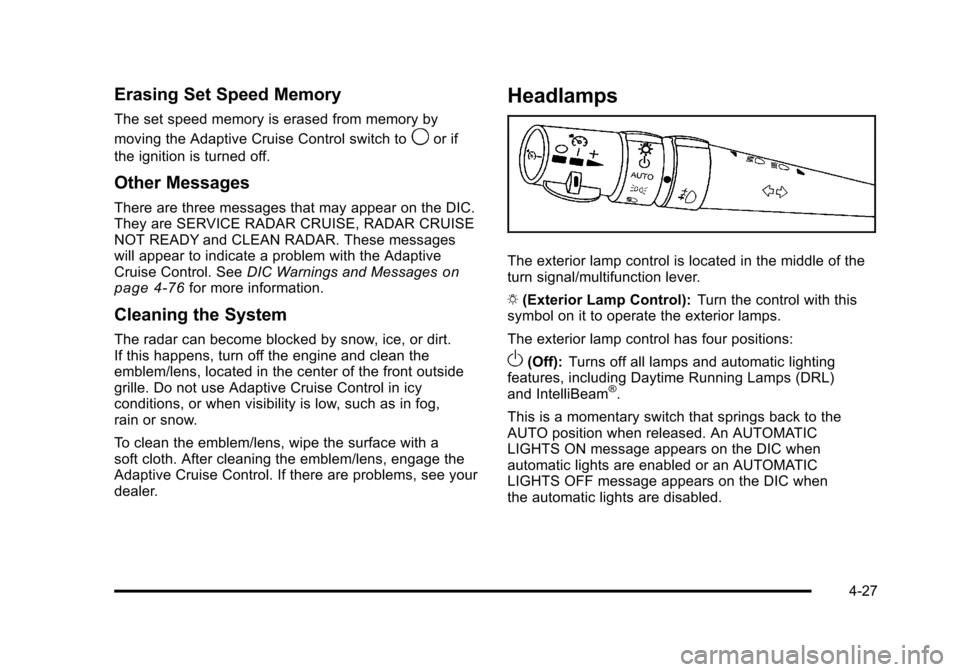
Black plate (27,1)Cadillac STS Owner Manual - 2011
Erasing Set Speed Memory
The set speed memory is erased from memory by
moving the Adaptive Cruise Control switch to
9or if
the ignition is turned off.
Other Messages
There are three messages that may appear on the DIC.
They are SERVICE RADAR CRUISE, RADAR CRUISE
NOT READY and CLEAN RADAR. These messages
will appear to indicate a problem with the Adaptive
Cruise Control. See DIC Warnings and Messages
on
page 4‑76for more information.
Cleaning the System
The radar can become blocked by snow, ice, or dirt.
If this happens, turn off the engine and clean the
emblem/lens, located in the center of the front outside
grille. Do not use Adaptive Cruise Control in icy
conditions, or when visibility is low, such as in fog,
rain or snow.
To clean the emblem/lens, wipe the surface with a
soft cloth. After cleaning the emblem/lens, engage the
Adaptive Cruise Control. If there are problems, see your
dealer.
Headlamps
The exterior lamp control is located in the middle of the
turn signal/multifunction lever.
O (Exterior Lamp Control): Turn the control with this
symbol on it to operate the exterior lamps.
The exterior lamp control has four positions:
O(Off): Turns off all lamps and automatic lighting
features, including Daytime Running Lamps (DRL)
and IntelliBeam
®.
This is a momentary switch that springs back to the
AUTO position when released. An AUTOMATIC
LIGHTS ON message appears on the DIC when
automatic lights are enabled or an AUTOMATIC
LIGHTS OFF message appears on the DIC when
the automatic lights are disabled.
4-27
Page 214 of 528
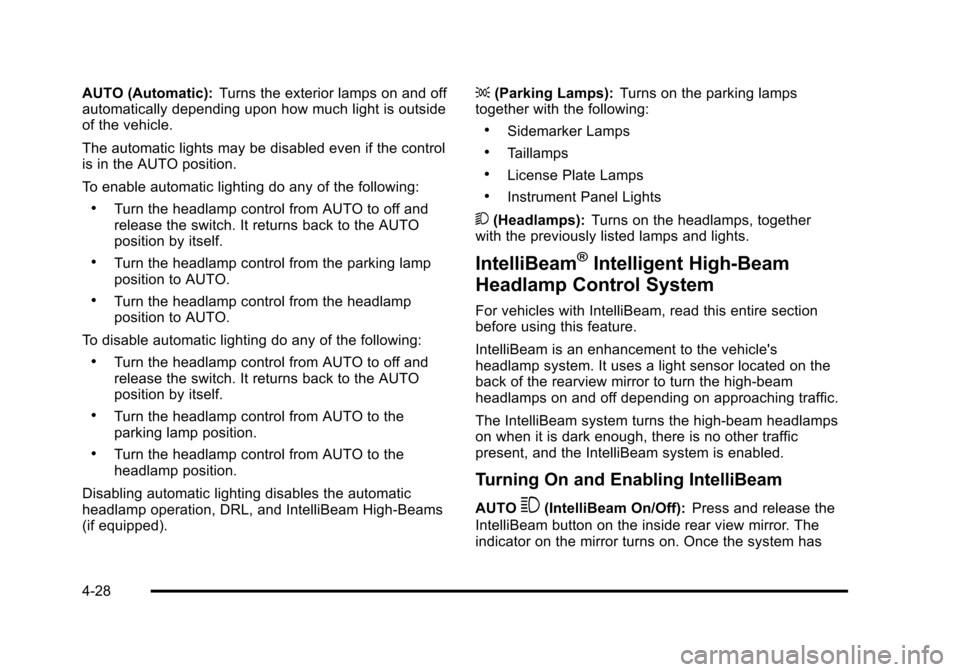
Black plate (28,1)Cadillac STS Owner Manual - 2011
AUTO (Automatic):Turns the exterior lamps on and off
automatically depending upon how much light is outside
of the vehicle.
The automatic lights may be disabled even if the control
is in the AUTO position.
To enable automatic lighting do any of the following:
.Turn the headlamp control from AUTO to off and
release the switch. It returns back to the AUTO
position by itself.
.Turn the headlamp control from the parking lamp
position to AUTO.
.Turn the headlamp control from the headlamp
position to AUTO.
To disable automatic lighting do any of the following:
.Turn the headlamp control from AUTO to off and
release the switch. It returns back to the AUTO
position by itself.
.Turn the headlamp control from AUTO to the
parking lamp position.
.Turn the headlamp control from AUTO to the
headlamp position.
Disabling automatic lighting disables the automatic
headlamp operation, DRL, and IntelliBeam High-Beams
(if equipped). ;
(Parking Lamps): Turns on the parking lamps
together with the following:
.Sidemarker Lamps
.Taillamps
.License Plate Lamps
.Instrument Panel Lights
5 (Headlamps): Turns on the headlamps, together
with the previously listed lamps and lights.
IntelliBeam®Intelligent High-Beam
Headlamp Control System
For vehicles with IntelliBeam, read this entire section
before using this feature.
IntelliBeam is an enhancement to the vehicle's
headlamp system. It uses a light sensor located on the
back of the rearview mirror to turn the high-beam
headlamps on and off depending on approaching traffic.
The IntelliBeam system turns the high-beam headlamps
on when it is dark enough, there is no other traffic
present, and the IntelliBeam system is enabled.
Turning On and Enabling IntelliBeam
AUTO3(IntelliBeam On/Off): Press and release the
IntelliBeam button on the inside rear view mirror. The
indicator on the mirror turns on. Once the system has
4-28
Page 215 of 528
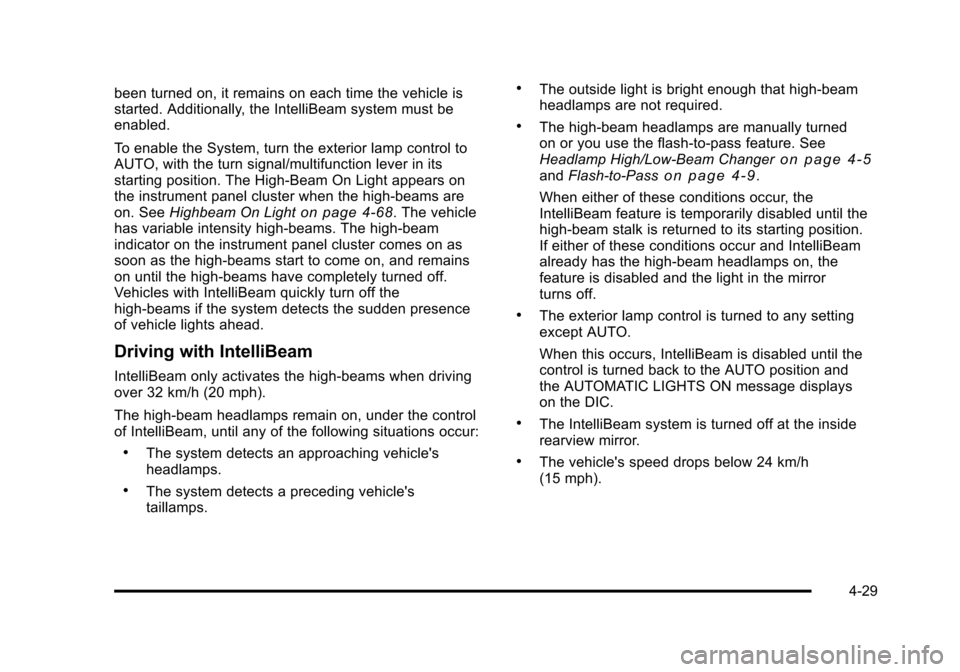
Black plate (29,1)Cadillac STS Owner Manual - 2011
been turned on, it remains on each time the vehicle is
started. Additionally, the IntelliBeam system must be
enabled.
To enable the System, turn the exterior lamp control to
AUTO, with the turn signal/multifunction lever in its
starting position. The High-Beam On Light appears on
the instrument panel cluster when the high-beams are
on. SeeHighbeam On Light
on page 4‑68. The vehicle
has variable intensity high-beams. The high-beam
indicator on the instrument panel cluster comes on as
soon as the high-beams start to come on, and remains
on until the high-beams have completely turned off.
Vehicles with IntelliBeam quickly turn off the
high-beams if the system detects the sudden presence
of vehicle lights ahead.
Driving with IntelliBeam
IntelliBeam only activates the high-beams when driving
over 32 km/h (20 mph).
The high-beam headlamps remain on, under the control
of IntelliBeam, until any of the following situations occur:
.The system detects an approaching vehicle's
headlamps.
.The system detects a preceding vehicle's
taillamps.
.The outside light is bright enough that high-beam
headlamps are not required.
.The high-beam headlamps are manually turned
on or you use the flash-to-pass feature. See
Headlamp High/Low-Beam Changer
on page 4‑5and Flash-to-Passon page 4‑9.
When either of these conditions occur, the
IntelliBeam feature is temporarily disabled until the
high-beam stalk is returned to its starting position.
If either of these conditions occur and IntelliBeam
already has the high-beam headlamps on, the
feature is disabled and the light in the mirror
turns off.
.The exterior lamp control is turned to any setting
except AUTO.
When this occurs, IntelliBeam is disabled until the
control is turned back to the AUTO position and
the AUTOMATIC LIGHTS ON message displays
on the DIC.
.The IntelliBeam system is turned off at the inside
rearview mirror.
.The vehicle's speed drops below 24 km/h
(15 mph).
4-29
Page 216 of 528
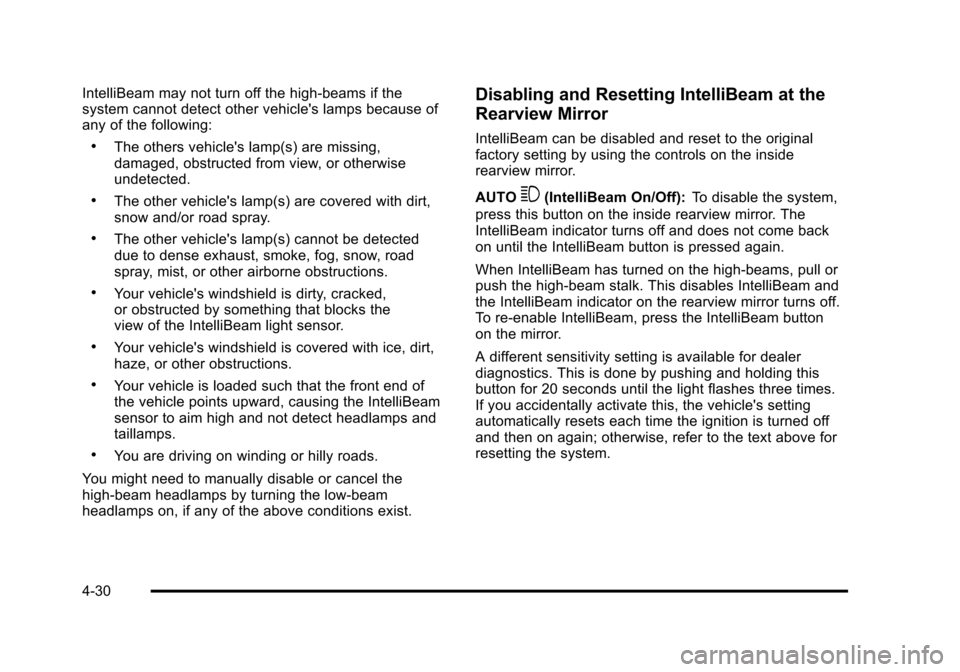
Black plate (30,1)Cadillac STS Owner Manual - 2011
IntelliBeam may not turn off the high-beams if the
system cannot detect other vehicle's lamps because of
any of the following:
.The others vehicle's lamp(s) are missing,
damaged, obstructed from view, or otherwise
undetected.
.The other vehicle's lamp(s) are covered with dirt,
snow and/or road spray.
.The other vehicle's lamp(s) cannot be detected
due to dense exhaust, smoke, fog, snow, road
spray, mist, or other airborne obstructions.
.Your vehicle's windshield is dirty, cracked,
or obstructed by something that blocks the
view of the IntelliBeam light sensor.
.Your vehicle's windshield is covered with ice, dirt,
haze, or other obstructions.
.Your vehicle is loaded such that the front end of
the vehicle points upward, causing the IntelliBeam
sensor to aim high and not detect headlamps and
taillamps.
.You are driving on winding or hilly roads.
You might need to manually disable or cancel the
high-beam headlamps by turning the low-beam
headlamps on, if any of the above conditions exist.
Disabling and Resetting IntelliBeam at the
Rearview Mirror
IntelliBeam can be disabled and reset to the original
factory setting by using the controls on the inside
rearview mirror.
AUTO
3(IntelliBeam On/Off): To disable the system,
press this button on the inside rearview mirror. The
IntelliBeam indicator turns off and does not come back
on until the IntelliBeam button is pressed again.
When IntelliBeam has turned on the high-beams, pull or
push the high-beam stalk. This disables IntelliBeam and
the IntelliBeam indicator on the rearview mirror turns off.
To re-enable IntelliBeam, press the IntelliBeam button
on the mirror.
A different sensitivity setting is available for dealer
diagnostics. This is done by pushing and holding this
button for 20 seconds until the light flashes three times.
If you accidentally activate this, the vehicle's setting
automatically resets each time the ignition is turned off
and then on again; otherwise, refer to the text above for
resetting the system.
4-30
Page 217 of 528
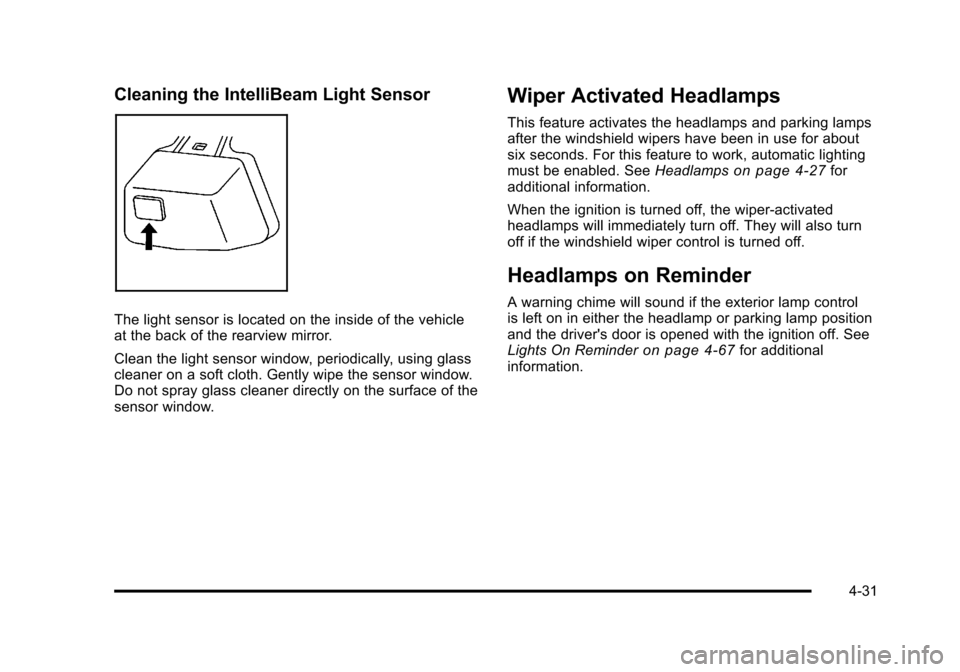
Black plate (31,1)Cadillac STS Owner Manual - 2011
Cleaning the IntelliBeam Light Sensor
The light sensor is located on the inside of the vehicle
at the back of the rearview mirror.
Clean the light sensor window, periodically, using glass
cleaner on a soft cloth. Gently wipe the sensor window.
Do not spray glass cleaner directly on the surface of the
sensor window.
Wiper Activated Headlamps
This feature activates the headlamps and parking lamps
after the windshield wipers have been in use for about
six seconds. For this feature to work, automatic lighting
must be enabled. SeeHeadlamps
on page 4‑27for
additional information.
When the ignition is turned off, the wiper-activated
headlamps will immediately turn off. They will also turn
off if the windshield wiper control is turned off.
Headlamps on Reminder
A warning chime will sound if the exterior lamp control
is left on in either the headlamp or parking lamp position
and the driver's door is opened with the ignition off. See
Lights On Reminder
on page 4‑67for additional
information.
4-31
Page 218 of 528
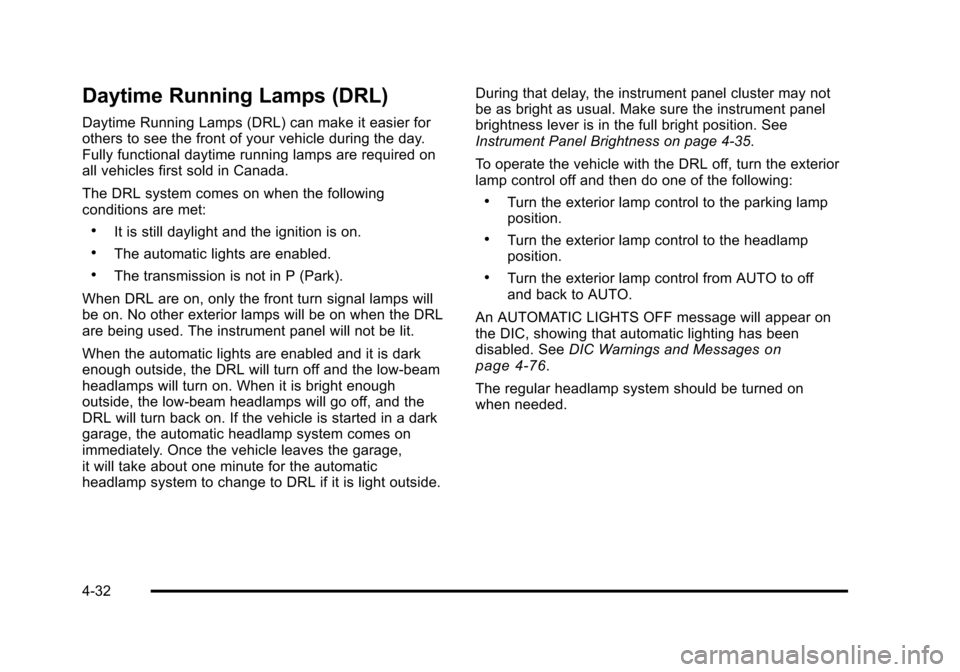
Black plate (32,1)Cadillac STS Owner Manual - 2011
Daytime Running Lamps (DRL)
Daytime Running Lamps (DRL) can make it easier for
others to see the front of your vehicle during the day.
Fully functional daytime running lamps are required on
all vehicles first sold in Canada.
The DRL system comes on when the following
conditions are met:
.It is still daylight and the ignition is on.
.The automatic lights are enabled.
.The transmission is not in P (Park).
When DRL are on, only the front turn signal lamps will
be on. No other exterior lamps will be on when the DRL
are being used. The instrument panel will not be lit.
When the automatic lights are enabled and it is dark
enough outside, the DRL will turn off and the low-beam
headlamps will turn on. When it is bright enough
outside, the low-beam headlamps will go off, and the
DRL will turn back on. If the vehicle is started in a dark
garage, the automatic headlamp system comes on
immediately. Once the vehicle leaves the garage,
it will take about one minute for the automatic
headlamp system to change to DRL if it is light outside. During that delay, the instrument panel cluster may not
be as bright as usual. Make sure the instrument panel
brightness lever is in the full bright position. See
Instrument Panel Brightness on page 4‑35.
To operate the vehicle with the DRL off, turn the exterior
lamp control off and then do one of the following:
.Turn the exterior lamp control to the parking lamp
position.
.Turn the exterior lamp control to the headlamp
position.
.Turn the exterior lamp control from AUTO to off
and back to AUTO.
An AUTOMATIC LIGHTS OFF message will appear on
the DIC, showing that automatic lighting has been
disabled. See DIC Warnings and Messages
on
page 4‑76.
The regular headlamp system should be turned on
when needed.
4-32
Page 219 of 528
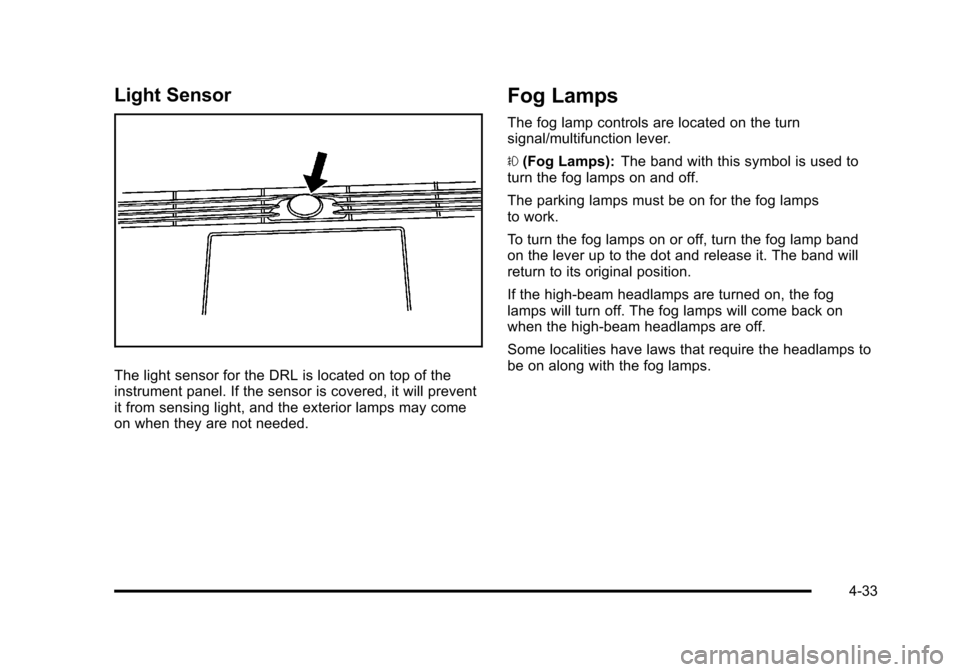
Black plate (33,1)Cadillac STS Owner Manual - 2011
Light Sensor
The light sensor for the DRL is located on top of the
instrument panel. If the sensor is covered, it will prevent
it from sensing light, and the exterior lamps may come
on when they are not needed.
Fog Lamps
The fog lamp controls are located on the turn
signal/multifunction lever.
#(Fog Lamps): The band with this symbol is used to
turn the fog lamps on and off.
The parking lamps must be on for the fog lamps
to work.
To turn the fog lamps on or off, turn the fog lamp band
on the lever up to the dot and release it. The band will
return to its original position.
If the high‐beam headlamps are turned on, the fog
lamps will turn off. The fog lamps will come back on
when the high‐beam headlamps are off.
Some localities have laws that require the headlamps to
be on along with the fog lamps.
4-33
Page 220 of 528

Black plate (34,1)Cadillac STS Owner Manual - 2011
Twilight Sentinel®
Twilight Sentinel®can turn the lamps on and off for you.
A light sensor on top of the instrument panel makes the
Twilight Sentinel work, so be sure it is not covered.With Twilight Sentinel the following will happen:
.When it is dark enough outside, the front turn
signal lamps (DRL) will go off, and the headlamps
and parking lamps will come on. The other lamps
that come on with headlamps will also come on.
.When it is bright enough outside, the headlamps
will go off, and the front turn signal lamps (DRL)
will come on, as long as the exterior lamp switch is
in the off position.
If the vehicle is started in a dark garage, the automatic
headlamp system comes on immediately. Once the
vehicle leaves the garage, it will take about one minute
for the automatic headlamp system to change to DRL if
it is light outside. During that delay, the instrument panel
cluster might not be as bright as usual. Make sure the
instrument panel brightness control is in full bright
position. See Instrument Panel Brightness
on
page 4‑35for more information.
You can idle the vehicle with the lamps off, even when it
is dark outside. First set the parking brake while the
ignition is in OFF/ACCESSORY. Then start the vehicle.
The lamps will stay off until the parking brake is
released.
4-34